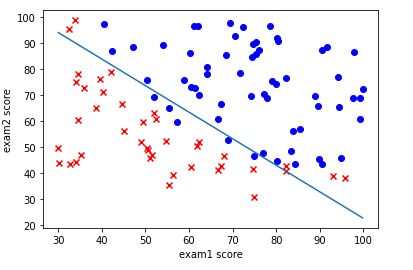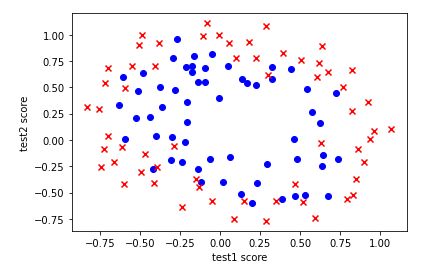吴恩达老师机器学习课程练习2:逻辑回归python实现
a0.将所需数据放入当前工作目录
In [ ]:
!git clone https://github.com/fengdu78/Coursera-ML-AndrewNg-Notes.git
Cloning into 'Coursera-ML-AndrewNg-Notes'...
remote: Enumerating objects: 4762, done.
remote: Total 4762 (delta 0), reused 0 (delta 0), pack-reused 4762
Receiving objects: 100% (4762/4762), 643.40 MiB | 38.98 MiB/s, done.
Resolving deltas: 100% (1323/1323), done.
Checking out files: 100% (462/462), done.
In [ ]:
%cd /content/Coursera-ML-AndrewNg-Notes/code/ex2-logistic regression
/content/Coursera-ML-AndrewNg-Notes/code/ex2-logistic regression
1.线性回归
问题描述:应用逻辑回归模型预测一个学生是否能考上大学
数据集:之前同学两门课的成绩以及是否被允许入学
1.1可视化数据
In [ ]:
import numpy as np
import pandas as pd
import matplotlib.pyplot as plt
In [ ]:
data1 = pd.read_csv('./ex2data1.txt',names=['exam1','exam2','admitted'])
data1.describe()
data1.head()
Out[ ]:
| exam1 | exam2 | admitted | |
|---|---|---|---|
| 0 | 34.623660 | 78.024693 | 0 |
| 1 | 30.286711 | 43.894998 | 0 |
| 2 | 35.847409 | 72.902198 | 0 |
| 3 | 60.182599 | 86.308552 | 1 |
| 4 | 79.032736 | 75.344376 | 1 |
In [ ]:
for i in range(len(data1.exam1)):
if data1.admitted[i] == 0:
plt.scatter(data1.exam1[i], data1.exam2[i], marker='x', c='r')
else:
plt.scatter(data1.exam1[i], data1.exam2[i], marker='o',c='b')
plt.xlabel('exam1 score')
plt.ylabel('exam2 score')
plt.show
Out[ ]:
1.2实现
1.2.1sigmoid函数
In [ ]:
def smd(z):
return 1 / (1 + np.exp(-z))
1.2.2代价函数和梯度
特别注意reshape()比T好用
In [ ]:
def cost(theta, x, y):
m = len(y)
inner = y * np.log(smd(x.dot(theta.reshape(3,1)))) + (1 - y) * np.log(1 - smd(x.dot(theta.reshape(3,1))))
return -np.sum(inner) / m
data1.insert(0, 'Ones', 1)
x = data1.iloc[:,0:3]
y = data1.iloc[:,3:4]
#代价函数是应该是numpy矩阵,所以我们需要转换X和Y,然后才能使用它们。 我们还需要初始化theta。
x = np.array(x)
y = np.array(y)
theta = np.zeros((1,3))
cost(theta, x, y)
Out[ ]:
0.6931471805599453
In [ ]:
def gradient(theta, x, y):
h = smd(x.dot(theta.reshape(3,1)))
m = len(y)
parameters = int(theta.size)
g = np.zeros(parameters)
for j in range(parameters):
x_j = x[:,j].reshape((m,1))
g[j] = np.sum((h - y) * x_j)/m
return g
In [ ]:
gradient(theta, x, y)
Out[ ]:
array([ -0.1 , -12.00921659, -11.26284221])
1.2.3优化
In [ ]:
import scipy.optimize as opt
result = opt.fmin_tnc(func=cost, x0=theta, fprime=gradient, args=(x, y))
result
Out[ ]:
(array([-25.16131863, 0.20623159, 0.20147149]), 36, 0)
In [ ]:
cost(result[0], x, y)
Out[ ]:
0.20349770158947458
1.2.4评估
In [ ]:
for i in range(len(data1.exam1)):
if data1.admitted[i] == 0:
plt.scatter(data1.exam1[i], data1.exam2[i], marker='x', c='r')
else:
plt.scatter(data1.exam1[i], data1.exam2[i], marker='o',c='b')
X = np.linspace(data1.exam1.min(),data1.exam1.max(),100)
last_theta = result[0]
print(last_theta)
Y = (-last_theta[0] - last_theta[1]*X)/last_theta[2]
plt.plot(X, Y)
plt.xlabel('exam1 score')
plt.ylabel('exam2 score')
plt.show
[-25.16131863 0.20623159 0.20147149]
Out[ ]:
In [ ]:
def predict(theta, x):
P = x.dot(theta.reshape(3,1))
return [1 if x >= 0.5 else 0 for x in P]
In [ ]:
P = predict(result[0], x)
right = 0
for i in range(len(P)):
if P[i] == y[i]:
right += 1
acc = right*100/len(P)
print('准确率为{0}%'.format(acc))
准确率为89.0
2.逻辑回归正则化
应用逻辑回归来判断一个芯片是否通过质检
2.1可视化数据
In [ ]:
data2 = pd.read_csv('./ex2data2.txt',names=['test1','test2','accepted'])
data2.head()
Out[ ]:
| test1 | test2 | accepted | |
|---|---|---|---|
| 0 | 0.051267 | 0.69956 | 1 |
| 1 | -0.092742 | 0.68494 | 1 |
| 2 | -0.213710 | 0.69225 | 1 |
| 3 | -0.375000 | 0.50219 | 1 |
| 4 | -0.513250 | 0.46564 | 1 |
In [ ]:
for i in range(len(data2.test1)):
if data2.accepted[i] == 0:
plt.scatter(data2.test1[i], data2.test2[i], marker='x', c='r')
else:
plt.scatter(data2.test1[i], data2.test2[i], marker='o',c='b')
plt.xlabel('test1 score')
plt.ylabel('test2 score')
plt.show
Out[ ]:
2.2实现
2.2.1 特征映射
In [ ]:
x1 = data2.test1
x2 = data2.test2
mapF = 6
for sum in range(mapF+1):
for i in range(sum+1):
data2['F' + str(i) + str(sum-i)] = np.power(x1, i) * np.power(x2, sum-i)
data2.head()
Out[ ]:
| test1 | test2 | accepted | F00 | F01 | F10 | F02 | F11 | F20 | F03 | F12 | F21 | F30 | F04 | F13 | F22 | F31 | F40 | F05 | F14 | F23 | F32 | F41 | F50 | F06 | F15 | F24 | F33 | F42 | F51 | F60 | |
|---|---|---|---|---|---|---|---|---|---|---|---|---|---|---|---|---|---|---|---|---|---|---|---|---|---|---|---|---|---|---|---|
| 0 | 0.051267 | 0.69956 | 1 | 1.0 | 0.69956 | 0.051267 | 0.489384 | 0.035864 | 0.002628 | 0.342354 | 0.025089 | 0.001839 | 0.000135 | 0.239497 | 0.017551 | 0.001286 | 0.000094 | 0.000007 | 0.167542 | 0.012278 | 0.000900 | 0.000066 | 0.000005 | 3.541519e-07 | 0.117206 | 0.008589 | 0.000629 | 0.000046 | 0.000003 | 2.477505e-07 | 1.815630e-08 |
| 1 | -0.092742 | 0.68494 | 1 | 1.0 | 0.68494 | -0.092742 | 0.469143 | -0.063523 | 0.008601 | 0.321335 | -0.043509 | 0.005891 | -0.000798 | 0.220095 | -0.029801 | 0.004035 | -0.000546 | 0.000074 | 0.150752 | -0.020412 | 0.002764 | -0.000374 | 0.000051 | -6.860919e-06 | 0.103256 | -0.013981 | 0.001893 | -0.000256 | 0.000035 | -4.699318e-06 | 6.362953e-07 |
| 2 | -0.213710 | 0.69225 | 1 | 1.0 | 0.69225 | -0.213710 | 0.479210 | -0.147941 | 0.045672 | 0.331733 | -0.102412 | 0.031616 | -0.009761 | 0.229642 | -0.070895 | 0.021886 | -0.006757 | 0.002086 | 0.158970 | -0.049077 | 0.015151 | -0.004677 | 0.001444 | -4.457837e-04 | 0.110047 | -0.033973 | 0.010488 | -0.003238 | 0.001000 | -3.085938e-04 | 9.526844e-05 |
| 3 | -0.375000 | 0.50219 | 1 | 1.0 | 0.50219 | -0.375000 | 0.252195 | -0.188321 | 0.140625 | 0.126650 | -0.094573 | 0.070620 | -0.052734 | 0.063602 | -0.047494 | 0.035465 | -0.026483 | 0.019775 | 0.031940 | -0.023851 | 0.017810 | -0.013299 | 0.009931 | -7.415771e-03 | 0.016040 | -0.011978 | 0.008944 | -0.006679 | 0.004987 | -3.724126e-03 | 2.780914e-03 |
| 4 | -0.513250 | 0.46564 | 1 | 1.0 | 0.46564 | -0.513250 | 0.216821 | -0.238990 | 0.263426 | 0.100960 | -0.111283 | 0.122661 | -0.135203 | 0.047011 | -0.051818 | 0.057116 | -0.062956 | 0.069393 | 0.021890 | -0.024128 | 0.026596 | -0.029315 | 0.032312 | -3.561597e-02 | 0.010193 | -0.011235 | 0.012384 | -0.013650 | 0.015046 | -1.658422e-02 | 1.827990e-02 |
2.2.2代价函数和梯度
In [ ]:
def cost2(theta, x, y, Lambda):
m = len(y)
n = np.size(theta)
inner = y * np.log(smd(x.dot(theta.reshape(n,1)))) + (1 - y) * np.log(1 - smd(x.dot(theta.reshape(n,1))))
first = -np.sum(inner) / m
second = Lambda*np.sum(np.power(theta, 2))/m/2
return first + second
x2 = data2.iloc[:,3:]
y2 = data2.iloc[:,2:3]
#代价函数是应该是numpy矩阵,所以我们需要转换X和Y,然后才能使用它们。 我们还需要初始化theta。
x2 = np.array(x)
y2 = np.array(y)
n = 28
theta2 = np.zeros((1,n))
Lambda = 1
cost2(theta2, x2, y2, Lambda)
Out[ ]:
0.6931471805599454
In [ ]:
def gradient2(theta, x, y, Lambda):
n = np.size(theta)
h = smd(x.dot(theta.reshape(n,1)))
m = len(y)
parameters = int(theta.size)
g = np.zeros(parameters)
theta = theta.reshape(1,n)
for j in range(parameters):
x_j = x[:,j].reshape((m,1))
g[j] = np.sum((h - y) * x_j)/m + Lambda * theta[0,j]/m
return g
gradient2(theta2, x2, y2, Lambda)
Out[ ]:
array([8.47457627e-03, 7.77711864e-05, 1.87880932e-02, 3.76648474e-02,
1.15013308e-02, 5.03446395e-02, 2.34764889e-02, 8.19244468e-03,
7.32393391e-03, 1.83559872e-02, 3.93028171e-02, 3.09593720e-03,
1.28600503e-02, 2.23923907e-03, 3.93486234e-02, 3.10079849e-02,
4.47629067e-03, 5.83822078e-03, 3.38643902e-03, 4.32983232e-03,
1.99707467e-02, 3.87936363e-02, 1.37646175e-03, 7.26504316e-03,
4.08503006e-04, 6.31570797e-03, 1.09740238e-03, 3.10312442e-02])
2.3优化
In [ ]:
result2 = opt.fmin_tnc(func=cost2, x0=theta, fprime=gradient2, args=(x2, y2, Lambda))
result2
Out[ ]:
(array([ 1.14201554, 1.16715861, 0.60123705, -1.26944057, -0.9156716 ,
-1.87180883, -0.17391049, -0.34494285, -0.36850133, 0.12678647,
-1.16320209, -0.26916597, -0.60631737, -0.04838602, -1.4237068 ,
-0.46912463, -0.28708915, -0.28008563, -0.04305276, -0.20697497,
-0.24269758, -0.93187605, -0.13795618, -0.32880531, 0.01716398,
-0.29250738, 0.02904399, -1.0362975 ]), 26, 1)
2.4评估
绘制非线性决策边界就需要使用机器学习库了
In [ ]:
def predict(theta, x):
n = np.size(theta)
P = x.dot(theta.reshape(n,1))
return [1 if x >= 0.5 else 0 for x in P]
P = predict(result2[0], x2)
right = 0
for i in range(len(P)):
if P[i] == y[i]:
right += 1
acc = right*100/len(P)
print('准确率为{0}%'.format(acc))
准确率为76.27118644067797%


